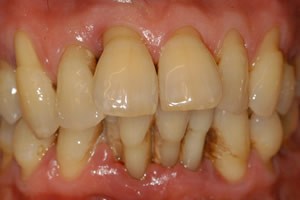Header logo
header top contact widget
Systemic Inflammation
Rheumatoid Arthritis (RA) Linked To Periodontal Disease
Posted on Oct 02, 2019 by William J. Claiborne, DDS MS
 As a periodontist, I specialize in the treatment of all stages of periodontal (gum) disease. Although this particular dental specialty is not as visible as a general dentist, we are very-involved members of the medical and dental community. According to the Centers for Disease Control & Prevention (CDC), over 47 percent of American adults have some level of gum disease.
As a periodontist, I specialize in the treatment of all stages of periodontal (gum) disease. Although this particular dental specialty is not as visible as a general dentist, we are very-involved members of the medical and dental community. According to the Centers for Disease Control & Prevention (CDC), over 47 percent of American adults have some level of gum disease.
Like the formation of cancer, many individuals are unaware when periodontal disease becomes active. When early symptoms appear (such as bleeding gums when brushing, bad breath and gum tenderness), many people shrug them off as temporary.
However, gum disease only progresses once underway. Eventually, gums become red in color and pus pockets form at the base of teeth. In advanced stages, teeth loosen and may require removal. Gum disease, to no surprise, is the nation’s leading cause of adult tooth loss.
The potent bacteria of periodontal disease can enter the bloodstream through tears in weakened gum tissues. This allows it to travel throughout the body. Research has shown it is able to trigger a number of serious health problems, including heart disease, stroke, diabetes, memory loss, and impotency.
Rheumatoid arthritis (RA), a condition seemingly unrelated to gum disease, is a debilitating disease that destroys joints. It is disabling and painful. In most cases, RA emerges gradually, often beginning with morning stiffness along with weak and aching muscles. Joint pain follows, with joints feeling sore and stiff. RA is typically found in the fingers, wrists, elbows, hips, knees, ankles, toes, shoulder and neck.
As inflammation from RA increases, joints become swollen with symptoms including fever, disfiguring of hands and feet, numbness and tingling. There is no cure for RA and lifelong treatment is required. Treatment may consist of medications, physical therapy, or even surgery.
Yet, like RA, gum disease causes pain, swelling, and tenderness. As it worsens, the associated inflammation can lead to destruction of the bone that supports teeth along with surrounding tissues. And, the similarities go much deeper.
Both gum disease and RA share a genetic likeness in clinical makeup and structures. This has been particularly apparent in pathogens, which are agents in the body that lead to disease or illness. The pathological processes that occurs in both gum disease and RA are almost identical.
Too, the particular species of bacteria found in gum-diseased oral tissues and tissues that surround joints in those who suffer with RA. Equally concerning is, while both conditions clearly cause chronic inflammation in tissues connected to bone, researchers have found the two diseases share a similar inflammatory trigger.
In one study, a particular pathogen associated with periodontal disease was found to activate the same destructive process of rheumatoid arthritis. It has also been shown that, by treating periodontal disease in RA patients, RA symptoms often improve ( likely due to the system’s reduced burden of oral inflammation).
These findings reveal just how closely our oral health correlates

A relaxing and comfy environment.
to our overall health. This information should send up alarms that the presence of gum disease can greatly increase your risk for serious health conditions. Clearly, people who have RA should be particularly diligent when it comes to their oral health.
If you are experiencing symptoms of gum disease (as mentioned above), seek treatment at your earliest convenience. You can begin with a consultation appointment in our comfortable Asheville periodontal office. A referral is not needed.
Call 828-274-9440 to learn more.
Using A Manual Or Electric Toothbrush Could Make A BIG Difference.
Posted on Sep 11, 2019 by William J. Claiborne, DDS MS
If you use an electric toothbrush, that can help in the prevention of tooth loss. However, it’s but one part of the steps needed for thorough oral hygiene at home.
Findings of an 11 year study published in the Journal of Clinical Periodontology tracked the oral health of over 2800 adults. Their use of electric toothbrushes was monitored to watch for periodontal disease, cavities, and the number of natural teeth.
Participants were examined in 2002 – 2006, with 18 percent being electric tooth brush users. Follow ups were conducted after six and 11 years. At the time of their 11 year follow up, 37 had converted to using electric toothbrushes.
The study showed electric brushing promoted better gum health and slower progression of gum disease. Electric tooth brushing also related to a reduction in tooth loss by 20 percent (compared to those who brush with manual toothbrushes). The study did not reveal measurable reduction in cavities, however.
Although more adults are using them, their long-term effectiveness has not been proven to be significant. It is suspected that this is due to technique more than the brushing tool itself. For manual brushers, a major hazard with manual brushes is one’s choice of bristles. Stiffer bristles can be very damaging.
If you use a hard bristle tooth brush, you may be damaging tooth enamel and gum tissues. People often feel they need to press down firmly as they brush and use a scrubbing, ‘back & forth’ motion. This action can wear down the protective shell of tooth enamel, leaving teeth more vulnerable to decay.
Another problem with using a hard bristle tooth brush is its ability to damage tender gum tissues. If the bristles on your toothbrush are fanned out after a couple of months, it’s because you are applying too much pressure when brushing.
The ideal technique for brushing teeth is applying gentle pressure on the brush in a swirling motion. By using a circular pattern over both sides of each tooth and along the tops, teeth are cleansed without wearing away gum tissues.
This is where electric toothbrushes can help greatly. Many of the newer models include timers to indicate the time needed for each quadrant of your mouth. This is your teeth divided into 4 sections. They also warn you when you are using too much pressure.
While tooth enamel is important, equally so are the health of your gum tissues. The gums provide a seal around the base of each tooth. This seal helps to prevent the entry of bacteria that can lead to periodontal (gum) disease, which the nation’s leading cause of adult tooth loss.
As devastating as tooth loss can be to one’s overall health, as we now know that the bacteria of gum disease can enter the bloodstream. Research has shown this infectious bacteria can trigger inflammatory reactions elsewhere in the body, correlating to heart disease, stroke, high blood pressure, some cancers, diabetes, arthritis, impotency, preterm babies and more.
Whether using a manual or electric tooth brush, it is necessary to brush twice a day for effective results. In order to thoroughly remove the sticky film of plaque from teeth, you should also brush at least two minutes each time.
Plaque is a buildup of oral bacteria that coats teeth and gums. If not removed daily, it forms a hardened mass of calculus (or tartar) that attaches to teeth. This is what you may feel your hygienist scraping off teeth during cleanings since it cannot be brushed or flossed away.
Another place for oral bacteria to thrive are the grooves in the tongue. These offer a dark, warm and moist environment for bacterial reproduction. To uproot these organisms (that reproduce rapidly), use your toothbrush to brush your tongue after brushing teeth. Be sure to reach the back of the tongue where the majority of oral bacteria are embedded. Swish with water several times after.
Another way to improve gum health, lower cavity risk, and prevent tooth loss is through flossing. It is estimated that only 31 percent of American adults floss on a daily basis. Because brushing cannot dislodge all food particles caught between teeth, daily flossing should be a part of oral hygiene routines.
Flossing removes trapped bits of food remain in the mouth, which feeds oral bacteria and helps them to quickly multiply. Proper flossing is easy for those who are in the habit of it and takes under a minute each day. For those who have problems with manual dexterity or find the maneuver awkward, water flossers are effective alternatives and easy to use.
Practice the recommended techniques mentioned above and you’ll not only do a better job at having a clean mouth, you’ll find your time at the sink requires less effort. If you feel you may be experiencing symptoms of periodontal disease, however, don’t delay. You should be seen at your earliest convenience for treatment since this disease will only worsen over time.
Signs of gum disease include tender gums that bleed easily when brushing, gums that darken in color to red (versus a healthy pink), frequent bad breath, and gums that pull away from teeth (receded gums) and expose darker root areas of the tooth.
If you’ve noticed any of these, please know that the condition will only worsen without treatment. As a periodontist, I specialize in gum tissues (as well as dental implants). Our environment optimizes patient outcomes and comfort throughout treatment.
Call 828-274-9440 to learn more.
Men Have Greater Risks For Dental Problems.
Posted on Aug 20, 2019 by William J. Claiborne, DDS MS
Research has found that periodontal disease is higher in men (56.4 percent) than in women (38.4 percent). https://www.perio.org/consumer/gum-disease-and-men
 The reason for this significantly higher number may be due to some findings revealed through some unsettling findings. According to a survey by the Centers For Disease Control & Prevention (CDC), only 66 percent of males brush their teeth twice or more a day compared with 86 percent of females who do so.
The reason for this significantly higher number may be due to some findings revealed through some unsettling findings. According to a survey by the Centers For Disease Control & Prevention (CDC), only 66 percent of males brush their teeth twice or more a day compared with 86 percent of females who do so.
This was revealed through a study of over 800 participants. Evaluation included a written questionnaire on dental knowledge and oral health habits. It also included an oral exam of each participant to detect signs of periodontal disease. (https://www.perio.org/consumer/gender-differences)
Flossing had even worse numbers, but that pertains to both sexes. Only 49 percent in the survey stated they floss on a daily basis. Only 1 out of 3 assumed that seeing blood in the sink when brushing is normal and were unaware it is a sign of periodontal (gum) disease.
While women were as twice as likely to see their dentist for regular dental check-ups, they were also more likely to follow through with recommended dental treatment than men. As a result, the study revealed women had better levels of gum health with less dental plaque, calculus, and bleeding.
The Journal of Periodontology shared nine risk factors for tooth loss due to periodontal (gum) disease, including …
• Being over age 35
• Being male
• Not having professional dental care
• Not brushing teeth
• Smoking
• Being diabetic
• Having high blood pressure
• Having RA (rheumatoid arthritis)
Although age and gender are unchangeable, decisions to not brush your teeth or to smoke, for example, are something you can control. As of 2017, 18.6 percent of American men smoke, compared with 14.3 percent of women. (https://www.edrugstore.com/blog/current-health-news/men-smoke-more/) Because more males smoke cigarettes (or use tobacco in other forms), they are more likely to develop gum disease.
Why should you worry about gum disease? In addition to causing tooth loss, oral bacteria can enter then bloodstream through tears in diseased tissues in the mouth. Once in the bloodstream, this bacteria can trigger inflammatory reactions elsewhere in the body.
The bacteria of gum disease has been linked to heart disease, stroke, memory loss, preterm babies, arthritis, diabetes, and even impotency. According to the American Academy of Periodontology (perio.org), men who fail to maintain good oral health are also at higher risk for:
PROSTATE PROBLEMS – Prostate-specific antigen (PSA) is an enzyme created in the prostate that is normally secreted in very small amounts. However, when the prostate becomes inflamed, infected, or affected by cancer, PSA levels rise. Research has shown that men with indicators of periodontal disease such as red, swollen or tender gums as well as prostatitis (inflammation of the prostate) have higher levels of PSA than men with only one of the conditions. This means that prostate health may be associated with periodontal health, and vice versa.
HEART DISEASE – Research indicates that periodontal disease and cardiovascular disease are associated; having periodontal disease may actually increase your risk of cardiovascular disease. Both diseases are chronic inflammatory conditions, and researchers believe that inflammation is the connection between gum disease and heart disease. Since men are already more likely to develop heart disease than women, maintaining periodontal health is another way to reduce this risk.
IMPOTENCE – Men with periodontal disease, especially those younger than 30 or older than 70, are at increased risk of developing impotence, according to research. Researchers believe that inflammation may be the link between the two conditions; prolonged chronic inflammation (the same type of inflammation that is associated with periodontal disease) can damage blood vessels leading to impotence.
CANCER – Research has found that men with a history of gum disease are 14 percent more likely to develop cancer than men with healthy gums. Specifically, men with periodontal disease may be 49 percent more likely than women to develop kidney cancer, 54 percent more likely to develop pancreatic cancer, and 30 percent more likely to develop blood cancers.
If you aren’t concerned about losing teeth, these overall health risks should get your attention. Treating gum disease before it becomes severe can be done comfortably and affordably. In our Asheville periodontal dental office, we use the latest technology and offer I.V. sedation for those who desire a “twilight sleep” state during treatment.
Gum disease will only worsen without treatment. Call (828) 274-9440 if you have tender, sore gums or see blood in the sink when brushing. You need to be seen promptly.
React To Gum Disease EARLY To Save Time & Money On Treatment.
Posted on Aug 08, 2019 by William J. Claiborne, DDS MS
“Hindsight is 20-20.”
This saying describes how, if we’d “known then what we know now…” we may have taken a different course of action for a better outcome.
In cases where gum disease develops or tooth loss occurs, patients often wish they could turn back the hands of time. Many patients who have acquired gum disease or had teeth replaced because of it are now highly-committed to their oral health. They often tell us, “I wish I’d taken better care of my mouth before,” now realizing how problems can be avoided as well as the benefits of good oral health.
Periodontal (gum) disease and (often) its subsequent tooth loss are, simply put, products of bacterial overload in the mouth. Our mouths are constantly being supplied with sustenance for these organisms. Bacteria are able to thrive through food that enters, especially sugars, and other bacteria-laden items put into the mouth. As bacteria thrive, they are able to reproduce very rapidly.
When bacteria levels become more than the immune system can tackle, infection can set in. Just as a cut or scrape on the skin that is not kept sufficiently clean can become infected, oral bacteria can cause an infection to develop in the mouth. This accumulation of bacteria can evolve into gum disease, which is an inflammation that attacks teeth, oral tissues and the bone structures that support tooth roots.
Gum disease symptoms include sore gums that bleed when brushing, frequent bad breath, gums that pull away from the base around teeth, gums that darken in color. As it worsens, pus pockets may form on the gums at the base of some teeth. In advanced stages, gum disease causes teeth to loosen and eventually require removal.
Gum disease often progresses because people are unaware that bleeding or receding gums is actually a symptom. Insufficient brushing, failing to floss and not having regular dental cleanings form a path that begin the process.
Insufficient care can lead to a build-up of bacteria, known as plaque. Plaque is a sticky (or “fuzzy”) film you feel on teeth when not removed on a regular basis. In just 48 hours, plaque can transform into a cement-hard colony of oral bacteria that attaches to teeth. This hardened form of bacteria is known as tartar or calculus. Unlike plaque, tartar cannot be brushed or flossed away.
As your mouth is enduring the repercussions of oral bacteria accumulation, gum tissues and tooth enamel are attacked. Once this infectious bacteria has penetrated below the gum line, dental treatment is necessary to halt its continued development and restore healthy gums
With prompt and proper measures, however, you can halt and reverse the need for dental treatment and avoid the repercussions of gum disease.
Gingivitis is the initial stage of gum disease. Symptoms typically include gums that are tender in spots and some bleeding when you brush. These are warning signs that signal an immediate need for attention.
Begin by twice daily brushing with a soft bristle tooth brush and use a fluoridated tooth paste. Brush for at least two minutes each time. Floss daily. Be sure not to pop the floss between teeth to avoid damaging tender gums. Move the floss in a back-&-forth motion between teeth to ease it down so you can scrape the sides of each tooth.
You can remove a tremendous amount of oral bacteria by using a tongue scrapper daily. Or, brush your tongue with your tooth brush at the end of each brushing. This helps to dislodge bacteria that is embedded in the grooves of the tongue.
Drink lots of water during the day. This will help keep saliva flow at ample levels. Saliva is designed to move oral bacteria from the mouth on a consistent basis. Oral dryness is the enemy. Avoid foods and beverages that are drying to oral tissues such as caffeine, alcohol, and spicy foods. Also, try to minimize the amount of sugar and carbohydrates you consume. These foods amplify the reproduction of oral bacteria.
If you smoke, consider using an oral rinse that replenishes moisture in the mouth. The chemicals in cigarette smoke are verey drying to oral tissues. Some oral rinses are specifically designed for producing moisture. Remember, oral dryness gives bacteria a favorable environment for reproduction.
When it comes to the initial formation of gingivitis, these steps will help relieve gum tenderness and potential to bleed within a week or so. If you do not see improvement after 2 weeks of diligent measures, see a periodontal specialist as soon as possible.
A periodontist is a dental specialist who can determine your precise level of gum disease and the most appropriate treatment to restore good oral health.
Call 828-274-9440 if you have questions about your gums or if you are experiencing any symptoms associated with gum disease.
Recent Posts
Categories
Archives
- September 2024
- August 2024
- July 2024
- June 2024
- May 2024
- April 2024
- March 2024
- February 2024
- January 2024
- December 2023
- November 2023
- October 2023
- September 2023
- August 2023
- July 2023
- June 2023
- May 2023
- April 2023
- March 2023
- February 2023
- January 2023
- December 2022
- November 2022
- October 2022
- September 2022
- August 2022
- July 2022
- June 2022
- May 2022
- April 2022
- March 2022
- February 2022
- January 2022
- December 2021
- November 2021
- October 2021
- September 2021
- August 2021
- July 2021
- June 2021
- May 2021
- April 2021
- March 2021
- February 2021
- January 2021
- December 2020
- November 2020
- October 2020
- September 2020
- August 2020
- July 2020
- June 2020
- May 2020
- April 2020
- March 2020
- February 2020
- January 2020
- December 2019
- November 2019
- October 2019
- September 2019
- August 2019
- July 2019
- June 2019
- May 2019
- April 2019
- March 2019
- February 2019
- January 2019
- December 2018
- November 2018
- October 2018
- September 2018
- August 2018
- July 2018
- June 2018
- May 2018
- April 2018
- March 2018
- February 2018
- January 2018
- December 2017
- November 2017
- October 2017
- September 2017
- August 2017
- July 2017
- June 2017
- May 2017
- April 2017
- March 2017
- February 2017
- January 2017
- December 2016
- November 2016
- October 2016
- September 2016
- August 2016
- July 2016
- June 2016
- May 2016
- April 2016
- March 2016
- February 2016
- January 2016
- December 2015
- November 2015
- October 2015
- September 2015
- August 2015
- July 2015
- June 2015
- May 2015
- April 2015
- March 2015
- February 2015
- January 2015
- December 2014
- November 2014
- October 2014
- September 2014
- August 2014
- July 2014
- June 2014
- May 2014
- April 2014
- March 2014
- February 2014
- January 2014
- December 2013
- November 2013
- October 2013
- September 2013
- August 2013
- July 2013
- June 2013
- May 2013
- April 2013
- March 2013
- February 2013
- January 2013
- December 2012
- November 2012
- October 2012
- September 2012
- August 2012
- July 2012
- June 2012


